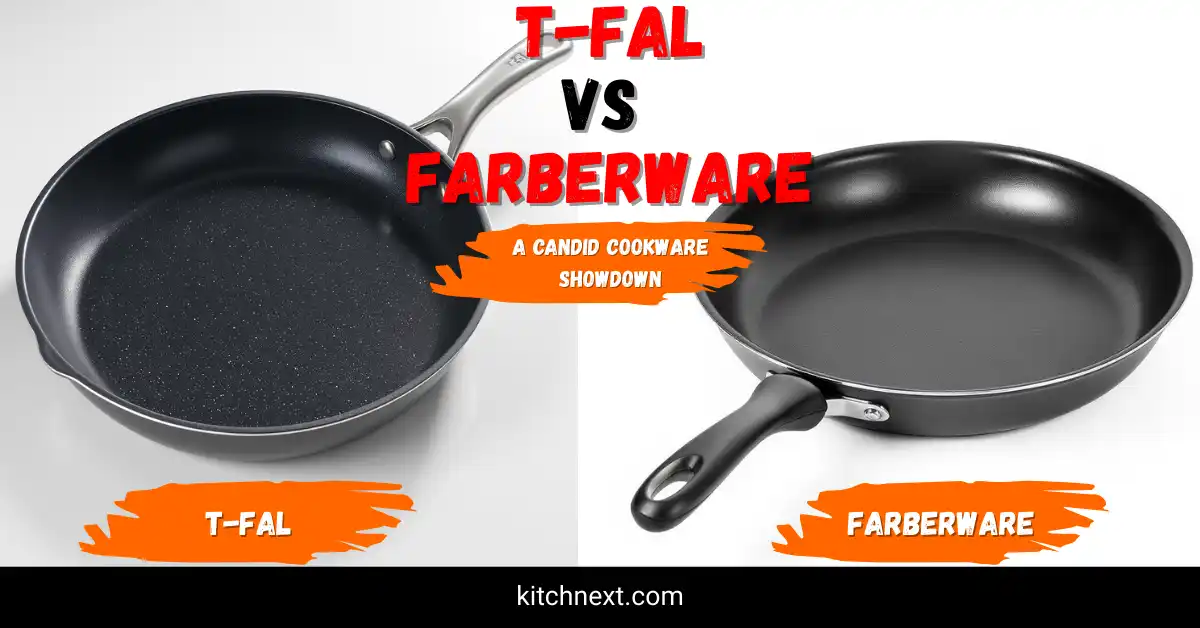If you’re stuck between T-fal vs Farberware, I’ve been there — juggling eggs on a pan that either sticks or warps can make or break your morning. Based on years of cooking everything from scrambled eggs to Sunday pasta, I can say both brands get the job done, but in very different ways. T-fal feels light and beginner-friendly, while Farberware brings classic heft and depth. After testing both in a real kitchen (not just reading reviews), I’ve broken them down so you don’t have to guess what works best for you. Ready to find your kitchen match? Let’s dive in.
Table of Contents
Is T-fal Pan Good?
Yes — for most home cooks, a T-fal pan is a dependable choice. I’ve used mine for quick breakfasts, stir-fries, and even delicate crepes, and it rarely disappoints. The nonstick coating is one of its biggest strengths. Food slides out with almost no effort, which makes cleanup a breeze.
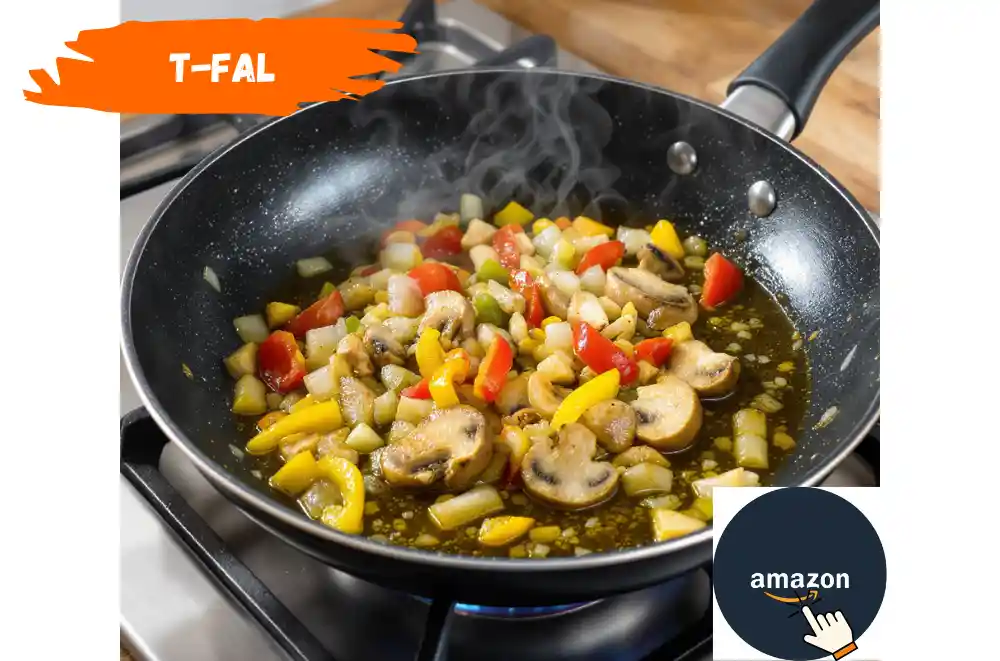
Check Latest Price and Offer at Amazon
The Thermo-Spot® heat indicator is surprisingly helpful. On busy mornings, I can glance at the pan and know exactly when it’s ready for eggs — no more guessing and risking sticking. The lightweight aluminum build means it heats fast, even on my electric stovetop.
In my kitchen, it’s been durable enough to survive daily use. While it won’t replace cast iron for searing steaks, it’s ideal for everyday cooking like sautéing vegetables or making pancakes for the kids. For U.S. buyers, it’s worth noting that T-fal pans are widely available in stores like Target, Walmart, and on Amazon, often at budget-friendly prices.
What I Like
- Effortless Nonstick Cooking – Eggs, pancakes, and fish lift right off without sticking. I use less oil, which is healthier and keeps cleanup simple.
- Thermo-Spot® Heat Indicator – This little red spot really works. It tells me when the pan is at the perfect cooking temperature, which makes frying more consistent.
- Lightweight but Sturdy – Easy to handle, even with one hand. Perfect when flipping omelets or moving a sauté pan from stovetop to oven.
- Versatile Sizes – My set includes a small 8-inch for quick eggs and a 12-inch skillet for family dinners. Sizes fit most U.S. stove burners well.
- Easy Maintenance – Most models are dishwasher-safe, but I handwash to keep the coating lasting longer.
What Could Be Better
- Not for High-Heat Cooking – The coating can wear faster if used on very high heat. I stick to medium or medium-high for best results.
- Limited Oven Tolerance – Many T-fal pans are oven-safe only up to about 350°F. That’s fine for finishing a frittata, but not for high-temp roasting.
- Induction Compatibility – Not all T-fal pans work on induction cooktops. U.S. buyers with induction stoves should double-check before buying.
Recommendation
If you want a reliable, affordable nonstick pan for daily use, T-fal is a strong pick. It’s especially good for beginners, busy parents, or anyone who cooks quick meals and values easy cleanup.
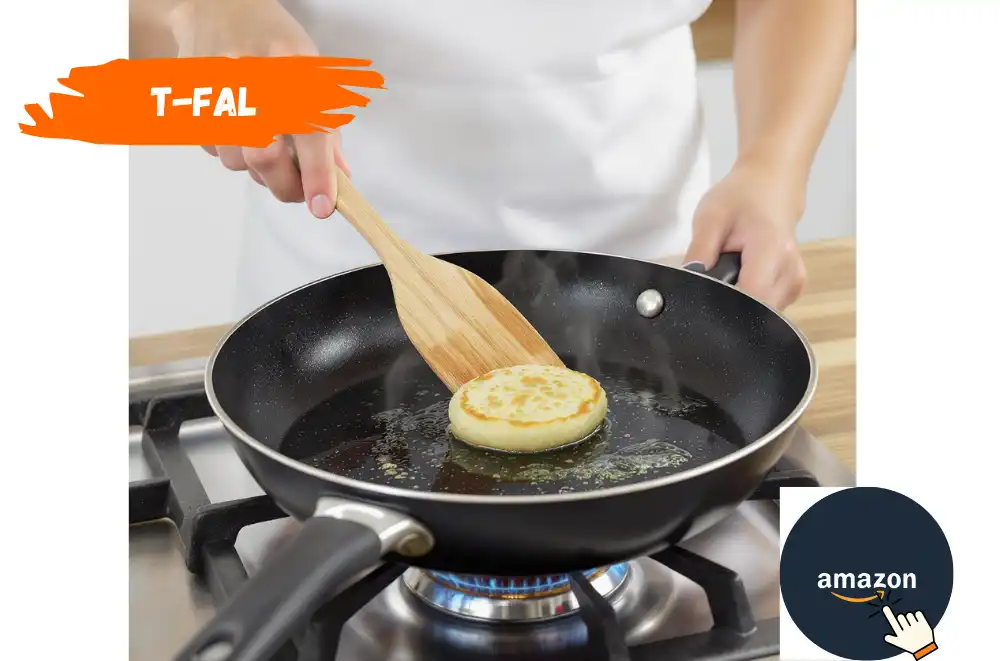
Check Latest Price and Offer at Amazon
If you do a lot of high-heat searing or want something that lasts a decade with heavy use, you might want to look into stainless steel or cast iron instead.
For most U.S. households, though, the T-fal pan hits that sweet spot between price, performance, and convenience. I keep mine in rotation alongside my stainless steel and cast iron, and it still gets the most weekday use.
Is Farberware Pan Good?
Yes — for everyday cooking, a Farberware pan is a solid choice.
I’ve used mine for quick weekday meals and longer weekend recipes. It’s easy to work with, and it doesn’t demand a lot of upkeep.
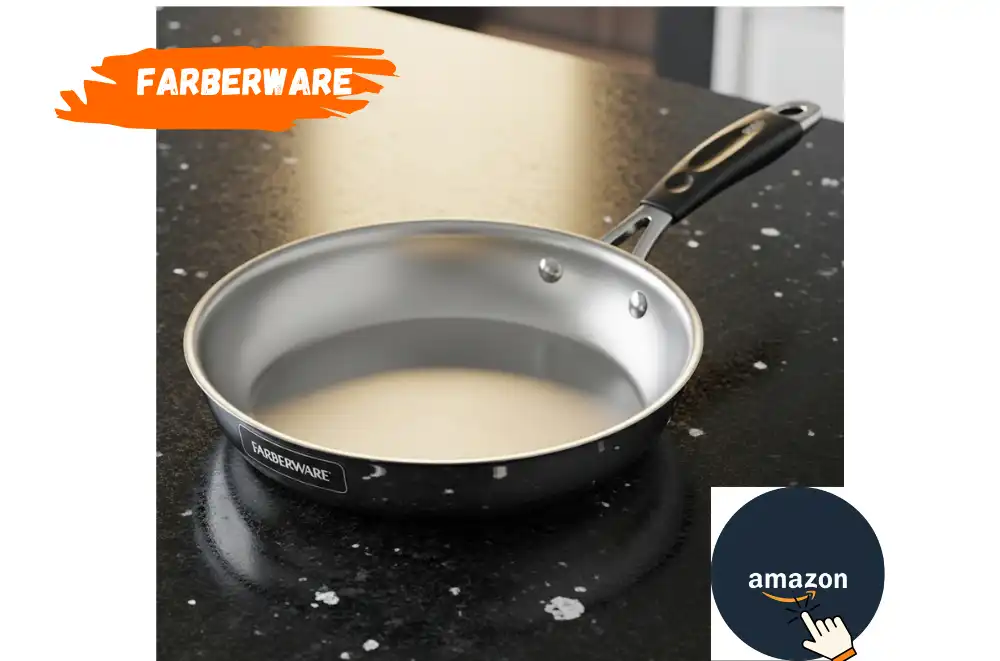
Check Latest Price and Offer at Amazon
One night, I used my 12-inch nonstick skillet to sear chicken, then simmer a lemon sauce right in the same pan. The heat spread evenly, so I didn’t get hot spots. Another time, I made a big breakfast for the family. Eggs slid out without sticking, and cleanup was quick with just warm water and a sponge.
Most Farberware pans use aluminum or stainless steel bases with nonstick or ceramic coatings. Many are dishwasher safe, and oven-safe up to a certain point — usually around 350–400°F. The handles stay cool during stovetop cooking, and the pans work on most stovetops, though some older models aren’t induction-ready.
What I Like
- Even heating without fuss – My skillet heats evenly, so I don’t have to keep moving food around to avoid burns.
- Easy cleanup – The nonstick surface means I can go from cooking to washing in under a minute. No scrubbing marathons.
- Affordable reliability – Farberware sits in that sweet spot where you get a dependable pan without paying premium-brand prices.
What Could Be Better
- Oven temperature limits – Some pans are only oven-safe to 350°F, which can feel limiting if you like finishing dishes in the oven.
- Surface care – The nonstick can scratch if you use metal utensils. A bit more scratch resistance would be great.
- Availability of larger sizes – In some lines, the 12-inch size is harder to find in the U.S., and I prefer it over smaller skillets.
Recommendation
If you’re in the U.S. and want a reliable, budget-friendly pan for daily cooking, Farberware is worth it.
It’s a good match for people who cook family meals, prefer easy cleanup, and don’t want cookware that feels heavy.
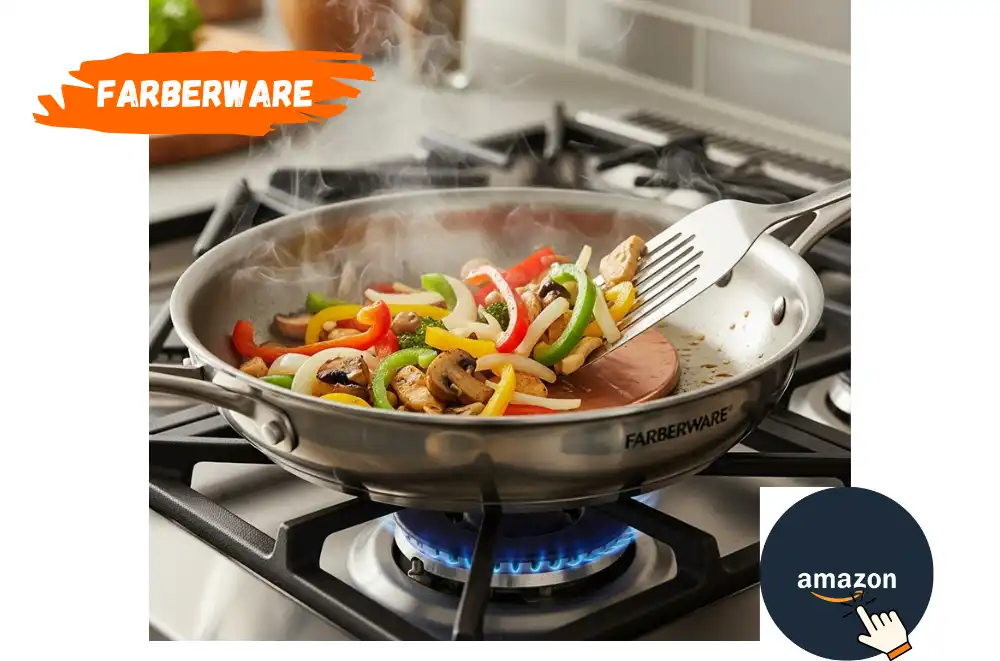
Check Latest Price and Offer at Amazon
If you do a lot of oven finishing at higher temps or want ultra-durable coatings, you might want to research other brands or specific Farberware lines like the ceramic-coated options.
For me, the pan has been a dependable workhorse. It’s not a luxury item, but it does what it promises — and that’s what I value most in cookware.
Details Comparison: T-fal vs Farberware
I’ve been testing out both T-fal and Farberware cookware sets over the past few months. Both brands offer great day-to-day performance in the kitchen, but in different ways. I’ve cooked everything from pancakes to pasta using both, and I’ve noticed some clear differences along the way. Let’s break it down to see which shines brighter in each area.
Pan Material: T-fal vs Farberware
T-fal uses lightweight aluminum while Farberware leans more toward stainless steel and forged aluminum. Both materials heat well but offer a different feel in hand.
| Feature | T-fal | Farberware |
|---|---|---|
| Pan Build | Hard Anodized / Aluminum | Stainless Steel / Forged Aluminum |
| Feel | Lightweight, even heat | Feels heavier, sturdy |
T-fal Rating: 9/10
Farberware Rating: 8.5/10
Cookware Options: T-fal vs Farberware
Both brands give you a wide range, including frying pans, griddles, saucepans, and Dutch ovens—but T-fal has more size sets and add-ons like steamers and egg pans.
| Feature | T-fal | Farberware |
|---|---|---|
| Set Variants | Multiple (2–17 pcs) | Fewer, simple sets |
| Special Pieces | Griddle, egg pan, steamer | Pasta pots, multi-deep pans |
T-fal Rating: 9.5/10
Farberware Rating: 8/10
Heat Distribution: T-fal vs Farberware
Heat spreads well across both, but T-fal’s Thermo-Spot tech helps users know when to start. Farberware’s thicker bottoms give steady heat but take longer to warm up.
| Feature | T-fal | Farberware |
|---|---|---|
| Heating Speed | Fast, consistent | Slower, steady heat |
| Heat Indicator | Yes (Thermo-Spot) | No |
T-fal Rating: 9.5/10
Farberware Rating: 8/10
Handle Material: T-fal vs Farberware
T-fal often uses silicone for comfort grip. Farberware uses stainless handles with rubber layers—sturdy but less heat-proof.
| Feature | T-fal | Farberware |
|---|---|---|
| Comfort | Soft silicone grip | Firmer grip |
| Oven Safety | Up to 400°F | Varies by model |
T-fal Rating: 9/10
Farberware Rating: 8/10
Closure Material: T-fal vs Farberware
Both brands use tempered glass lids, but T-fal adds vent holes more often. It helps with boiling and steam control.
| Feature | T-fal | Farberware |
|---|---|---|
| Lid Material | Glass with vent | Glass (some lids no vent) |
| Visibility | Yes | Yes |
T-fal Rating: 9/10
Farberware Rating: 7.5/10
Non-Stick Quality: T-fal vs Farberware
Both brands have lasting non-stick performance early on. T-fal’s titanium-reinforced layer resists wear better.
| Feature | T-fal | Farberware |
|---|---|---|
| Egg Test Result | Slides clean with oil spray | Slides, may need more oil |
| Surface Feel | Smooth, easy release | Smooth with texture (in some pans) |
T-fal Rating: 9/10
Farberware Rating: 8/10
Non-Stick Coating: T-fal vs Farberware
T-fal uses titanium or ceramic in some sets. Farberware uses traditional or ceramic nonsticks. Both are Teflon/PFOA-free in current versions.
| Feature | T-fal | Farberware |
|---|---|---|
| Type of Coating | Titanium/Ceramic | Ceramic/Traditional |
| Oil Needed? | Minimal | Slightly more |
T-fal Rating: 9/10
Farberware Rating: 8.5/10
Durability: T-fal vs Farberware
T-fal’s hard anodized pans hold up to wear better over time. Farberware handles long-term use well but may scratch faster inside.
| Feature | T-fal | Farberware |
|---|---|---|
| Scratch Resistance | High | Moderate |
| Long-Term Use | Lasts well daily | May wear under heavy use |
T-fal Rating: 9.5/10
Farberware Rating: 8/10
Cooking Surface: T-fal vs Farberware
Both give wide, open pans that are easy to clean. Farberware pans often have deeper walls—ideal for one-pan recipes.
| Feature | T-fal | Farberware |
|---|---|---|
| Cooking Width | Wider, shallow | Deep, roomy walls |
| Cleaning Ease | Very easy | Easy |
T-fal Rating: 9/10
Farberware Rating: 9/10
Performance: T-fal vs Farberware
T-fal heats quicker and is more user-friendly for beginners. Farberware gives weight and depth, which pros may prefer.
| Feature | T-fal | Farberware |
|---|---|---|
| Speed | Quick heat-up | Slower but steady |
| Everyday Use Score | High | Moderate for all dishes |
T-fal Rating: 9/10
Farberware Rating: 8.5/10
Ease of Use: T-fal vs Farberware
If you want grab-and-go cooking, T-fal is ready out of the box. Farberware may feel harder to lift for some users.
| Feature | T-fal | Farberware |
|---|---|---|
| User-Friendly | Extremely | Better for practiced hands |
| Weight | Light | Mid to heavy |
T-fal Rating: 9.5/10
Farberware Rating: 8/10
Feature: T-fal vs Farberware
Both offer basic and advanced sets. T-fal adds smart features like heat spots and vent lids.
| Feature | T-fal | Farberware |
|---|---|---|
| Heat Indicator | Yes (Thermo-Spot) | No |
| Oven Safe | Up to 400°F | Up to 350°F (usually) |
T-fal Rating: 9/10
Farberware Rating: 8/10
Stickiness: T-fal vs Farberware
Both pans work best with light oil. T-fal glides a bit easier when frying eggs or pancakes.
| Feature | T-fal | Farberware |
|---|---|---|
| Egg Test | Slides with little oil | May stick with no oil |
| Sticky Foods | Handles well | May cling slightly |
T-fal Rating: 9/10
Farberware Rating: 8/10
Is the item dishwasher safe?: T-fal vs Farberware
T-fal is machine-safe and stays shiny longer. Farberware is dishwasher-safe too, though handwashing is often better for longevity.
| Feature | T-fal | Farberware |
|---|---|---|
| Dishwasher Safe | Yes | Yes |
| Surface After Wash | Little wear | May show spots |
T-fal Rating: 9/10
Farberware Rating: 8.5/10
Overall & Warranty: T-fal vs Farberware
T-fal stands out for beginners and light bakers, while Farberware might be your choice for heavier kitchen tasks. Both offer limited lifetime warranties.
| Feature | T-fal | Farberware |
|---|---|---|
| Brand Support | Lifetime Limited Warranty | Lifetime Limited Warranty |
| Versatility | Easy for daily cooking | Great for hardy meals |
T-fal Rating: 9/10
Farberware Rating: 8.5/10
Price: T-fal vs Farberware
T-fal might cost a little more depending on the set, but you get more features. Farberware is a solid mid-range value.
| Set Size | T-fal Approx | Farberware Approx |
|---|---|---|
| 12-Piece Set | $99–$110 | $90–$120 |
| 17-Piece Set | $200–$239 | $150–$199 |
T-fal Rating: 8.5/10
Farberware Rating: 8.5/10
Final Thoughts: Which One Wins?
Both T-fal and Farberware bring strength in different ways. T-fal is better for fast cooking, lighter handling, and easy features like the heat spot. Farberware edges toward deeper pans, tougher tasks, and old-school heft.

Check Latest Price and Offer at Amazon
If you’re new to the kitchen, T-fal is a perfect guide. If you want tools that stay with you through thick and thin, Farberware might be the reliable friend you’re after.
Both brands are great. It just depends on what kind of “cook” you are.
FAQ: T-fal vs Farberware
Is T-fal better than Farberware for beginners?
T-fal is great for beginners thanks to its quick heating and easy-to-use features. Farberware is better if you prefer a heavier, old-school feel. Learn more about both options.
Which cookware lasts longer: T-fal vs Farberware?
T-fal’s titanium coating gives it an edge for longer use. Farberware holds up well too, but may show wear faster. See which one fits your cooking needs best.
Does Farberware cookware heat as fast as T-fal?
No, T-fal heats faster due to its aluminum core and heat spot. Farberware takes longer but holds heat better. Learn more about their heat tech in the full comparison.
Are T-fal and Farberware both dishwasher safe?
Yes, most T-fal and Farberware sets are dishwasher safe. But handwashing helps keep non-stick coatings in shape longer. Explore tips to clean both brands.
What’s the main difference between T-fal vs Farberware?
T-fal is lighter and faster to cook with. Farberware feels sturdier and often comes in deeper pans. Find out which brand suits your kitchen style.

